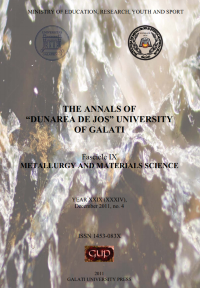Phosphate Passivation Solutions Enhanced by Chemical Additives for Treatment of the Hot Dip Galvanized Steel
Abstract
To stabilize the surface of the galvanized steel it is important to apply a passivation treatment during its manufacturing. The general aim of the passivation treatment is to prevent the formation “storage stain” or “white rust”. For many decades, the chromium conversion treatments involving the use of chromic acid containing Cr6+ species have been used for their corrosion protection and adhesion promotion performances. Today all hexavalent chromates have been banned by the EC. Toxicological studies have evidenced the hazardous character of hexavalent chromium. Therefore more economical and environmentally friendly passivation solutions have been studied and used to replace the chrome passivations on galvanized steel.
Phosphate conversion coatings are commonly used on the galvanized steel. They form a thin protective film on steels surface. However, the formation of a stable and uniform coating for corrosion protection remains a challenge. More complexes passivating solutions with chemical activators added are the potential alternatives.
In this paper are presented the studies about such molybdate–phosphate passivation solutions as environmentally friendly alternative for chromium passivates. The results of treatments realized for different treatment times and more compositions were analyzed. Also the corrosion resistance of the passivated samples has been studied.
Downloads
References
[2]. LIU Guangming, YU Fei, Yang Liu, Tian Jihong, and DU Nan - Cerium-tannic acid passivation treatment on galvanized steel, Cerium-tannic acid passivation treatment on galvanized steel Rare Metals, Vol. 28, No. 3, Jun 2009, p. 284.
[3]. Hao J.J., An C.Q., and Mou S.H. - Advances in research on unchromium passivation of galvanized zinc layer, Mater.Rev., 2003, 9 (17).
[4]. Thierry L., Pommier N. - Hexavalent chromium-free passivation treatments in the automotive industry, COVENTYA SAS, April 2003.
[5]. Yunying Fan, Yehua Jiang, Rong Zhou - New passivating method to galvanized Zn coatings on steel substrate, Advanced Materials Research Vols.163-167 (2011), pp.4555-4558.
[6]. Wang D. and Tang X. - A study of the film formation kin etics on zinc in different acidic corrosion inhibitor solutions by quartz crystal microbalance, Corros. Sci., 2005, 9 (47): 2157.
[7]. Bexell U. and Grehk T.M. - A corrosion study of hot-dip galvanized steel sheet pre-treated with γmercaptopropyltrimethoxysilane, Surf. Coat. Technol., 2007, 201:4734.
[8]. Deflorian F., Rossi S., Fedrizzi L., and Bonora P.L. - EIS study of organic coating on zinc surface pretreated with environmentally friendly products, Prog. Org. Coat., 2005, 52:271.]. The phosphating is one of the most important chemical conversion processes used for corrosion protection or painting primer for the galvanized layers.
[9]. Lorin G. - Phosphating of metals: constitution, physical chemistry and technical applications of phosphating solutions [M]. Hampton Hill: Finishing Publications, 1974: 146−155.
[10]. Freeman D B. - Phosphating and metal pre-treatment [M]. New York: Industrial Press, 1986: 134−139.
[11]. Rausch W. - The phosphating of metals [M]. Ohio: ASM International, 1990: 112−116.1−3.
[12]. Vukasovich M S, Farr J P G. - Molybdatein corrosion inhibition—A review [J]. Mater Perform, 1986, 25(5): 9−18.
[13]. Aramaki K. - The inhibition effects of chromate-free, anion inhibitors on corrosion of zinc in aerated 0.5 mol/L NaCl [J]. Corros.Sci, 2001, 43(3): 591−604.
[14]. Li Guang-yu, Niu Li-yuan, lian Jian-she, Jiang Zhong-Hao - A black phosphate coating for C1008 steel [J]. Surf Coat Technol, 2004, 176(2): 215−221.
[15]. Saliba-Silva A M, de Oliveira M C L, Costa I. - Effect of molybdate on phosphating of Nd-Fe-B magnets for corrosion protection [J]. Mater Res Bull, 2005, 8(2): 147−150.
[16]. Lin Bi-lan, Lu Jin-tang, Kong Gang, Liu Jun. Growth and corrosion resistance of molybdate modified zinc phosphate conversion coatings on hot-dip galvanized steel [J]. Trans Nonferrous Met Soc China, 2007, 17(4): 755−761.
[17]. Lu Jin-tang, Kong Gang, Chen Jin-Hong, Xu Qiao-Yu, Sui Run-Zhou. - Growth and corrosion behavior of molybate passivation film on hot dip galvanized steel [J]. Trans Nonferrous Met Soc China, 2003, 13(1): 145−148.
[18]. Tang T. and Beth-Nielsen G. - Molybdate-based alternatives to chromating as a passivation treatment for zinc, Plat. Surf.Finish., 1994, 18 (11): 20.
[19]. Ogle K., Tomandl A., Meddahi N., Wolpers M. - The alkaline stability of phosphate coatings I: ICP atomic emission spectroelectrochemistry, Corrosion Science 46 (2004) pp.979–995.
[20]. Ogle K., Bucheit R. - Conversion coatings, in: A.J. Bard, M. Stratmann (Eds.), Encyclopedia of the Electrochemistry, vol. 5, Wiley-VCH, Weinheim, 2003, p. 460.
[21]. Brooman E.W. - Chromium alloy plating, ASM Handb Int. 5 (1994) 270.
[22]. Sankara Narayanan T.S.N. - Surface Pretreatment By Phosphate Conversion Coatings. A REVIEW, Rev.Adv.Mater.Sci. 9 (2005) 130-177.



